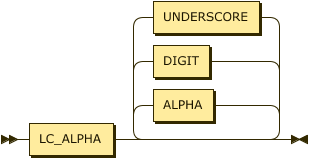Relations & Facts
While relations are a key aspect of the Datalog language there is no actual production for relation in the syntax. This is because the syntax instead expects a set of facts expressed and where those facts share the same label, and are schema compatible they comprise a relation. Each relation has a schema that defines the number of attributes, their types, and optionally their labels. The number of attributes is often termed the arity of the relation or of a fact.
In some literature, where Datalog is analyzed from a model theoretic view, the term sort is more often used than schema. In either case the meaning is equivalent. See Wilfred97 and AbHuVi94.
Facts may be either asserted (added to a relation), or retracted (removed from a relation).

fact ::= assertion | retraction ;
Assertion is denoted by a fact body followed by the perion, '.' character.

assertion
::= fact-body "." ;
Retraction is denoted by a fact body followed by the tilde, '~' character.
As a relation is a set of facts, each fact is syntactically unique and
addition and removal are based on the equality relation for each constant type.

retraction
::= fact-body "~" ;
Retraction of a fact which is not a member of the relation MUST NOT be treated as an error, although it MAY BE handled with a warning or informational message.
The body of a fact is expressed in the form of ground
§ Atoms where all
§ Terms are constant, and so they have a
specific production rather than a constrained form of the atom rule. A
predicate is the identifying label shared by a relation and its facts.

fact-body
::= predicate ( "(" constant ( "," constant )* ")" )? ;
A predicate is a string of characters that MUST start with a character from the Unicode category Ll.

predicate
::= LC_ALPHA ( ALPHA | DIGIT | UNDERSCORE )* ;
Errors
Attempting to add a fact that is schema incompatible with an explicitly
declared extensional relation MUST signal the error ERR_INCONSISTENT_FACT_SCHEMA.
.assert human(string).
human(22).
%% ==> ERR_INCONSISTENT_FACT_SCHEMA
It is an error to add a fact that is schema incompatible with an implicitly inferred extensional relation. In this case the first occurrence of human had a string value and so a relation was inferred with a single string attribute.
human(socrates).
human(22).
%% ==> ERR_INCONSISTENT_FACT_SCHEMA
Some cases may not be so obvious, especially with numerics. The value 22 is inferred to be integer, the value 22.0 is inferred to be a decimal, and the value 22.0e2 is inferred to be a float. Therefore, the example below causes an error.
human(22). % integer
human(22.0). % decimal
human(22.0e+2). % float
%% ==> ERR_INCONSISTENT_FACT_SCHEMA
It is also an error to assert facts where the label identifies an intensional, rather than extensional relation.
.assert human(string).
.infer mortal from human.
mortal(22).
%% ==> ERR_PREDICATE_NOT_AN_EXTENSIONAL_RELATION
In this final example the error is caused by processing in strict mode where all relations MUST be declared via processing instructions before use.
.pragma strict.
human(socrates).
%% ==> ERR_PREDICATE_NOT_AN_EXTENSIONAL_RELATION
Examples
The following demonstrates a simple fact denoting that the constant brooke representing some
individual is the parent of some individual represented by the constant "Xerces".
parent("Xerces", brooke).
In a graph program an edge can be represented as an edge with a source vertex, target vertex, and weight.
edge(src, tgt, 100).